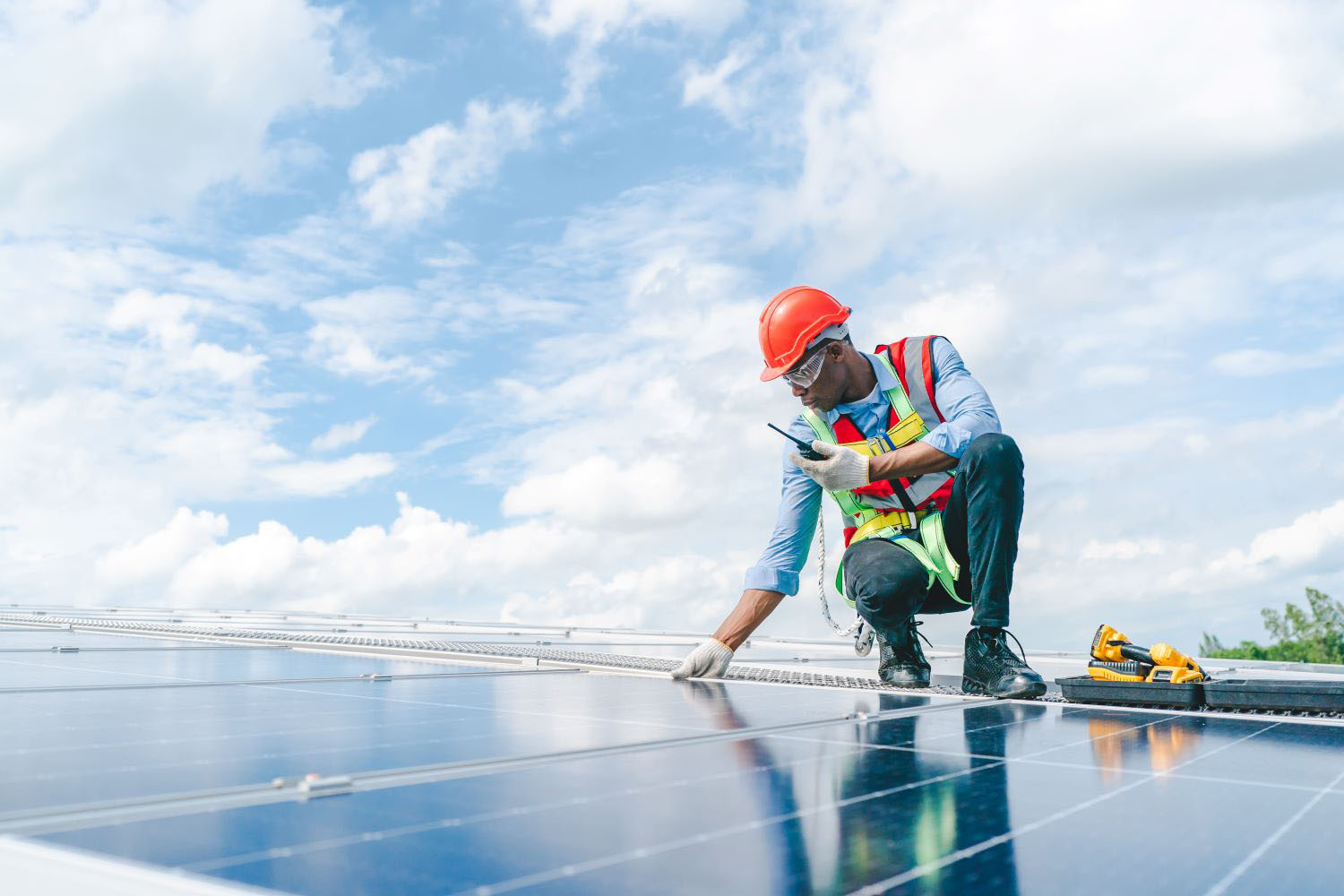Recommended

Blog Post
Over the coming decades, the world must decarbonise at an unprecedented speed. Yet deploying ‘green’ technologies cannot be done without a sufficiently sized and adequately skilled workforce. New research from the Center for Global Development suggests that workforce gaps pose a significant bottleneck to achieving the green transition. Across all of the 10 countries studied, domestic labour supply pipelines are unlikely to meet growing demand. Migration, combined with investments in training, will be necessary.
The green transition is urgent…
To prevent catastrophic planetary warming, carbon emissions must be reduced in highly condensed timeframes. In practice, this requires energy transitions of unprecedented speed, occurring simultaneously across the globe. To limit warming below 1.5 degrees Celsius—the goal set in the 2015 Paris Agreement, and perhaps already unobtainable—net zero emissions must be achieved globally between 2050 and 2060, with tight benchmarks in the intervening decades.
This green transition is already underway, but meeting these targets will be extremely challenging. In China, India, and South Africa, for example, coal power generation must be reduced at a speed twice as fast as any previous energy transition. Countries’ ability to achieve this will be affected by many factors, including access to financing; access to raw materials; and the stability of key supply chains. Yet another factor, the need to have a sufficient workforce, is frequently forgotten.
… and will demand new skills
The International Energy Agency (IEA) estimates that around 30 million new ‘green jobs’ will be created by 2030. All 10 of the countries studied in CGD’s new report will not meet their green transition targets without significantly scaling up their workforce. This will have to happen in an unusually short amount of time.
The jobs created by the green transition are often relatively unskilled. The IEA estimates that only 60 percent of these jobs will require any degree of post-secondary training. In the United States, nearly 60 percent of the green jobs created by the new Inflation Reduction Act (IRA) are estimated not to need a college degree, and only 11 percent to need an occupational or vocational certificate. Within Australia’s solar photovoltaic (PV) workforce, only 17 percent hold a tertiary qualification and 23 percent have no post-secondary qualifications whatsoever. In Germany, solar PV installers often work after only a few weeks of training.
Demand is already extremely high and will grow. In the United Kingdom, up to 725,000 net new green jobs are estimated to be created by 2030. Up to 69,500 heat pump installers could be needed by 2035 (versus 3,000 in 2022), and around 35,000 workers in the solar sector by 2030 (versus 6,500 in 2022). In the United States, the IRA is expected to create between 1.5 and 2.9 million new jobs by 2030; the solar PV workforce will need to double from 255,000 workers in 2022 to 538,000 in 2032. Australia will need an additional 42,000 electricians by 2030, and Germany already faces a shortage of 30,000. In India, the national Skill Council for Green Jobs (SCGJ) expects the green transition to create 24 to 35 million new jobs by 2050, of which around 3 million will be in the solar industry.
The challenge of skill supply
In almost all countries, meeting these skill demands will be very difficult. The IEA has already observed that a shortage of skills is translating into project delays and changes to investment decisions. In Spain, solar PV companies are turning down installation requests due to a lack of capacity. In the Netherlands, a lack of installers is reported to be the key bottleneck for heat pump installations. In South Africa, the Just Energy Transition Partnership (JETP) has set aside US$140 million for skill development, but a Presidential Climate Commission found in 2023 that the work done so far remains highly insufficient.
Despite the relatively limited skills often needed for green jobs, sourcing domestic workers is challenging for seven main reasons.
- Green jobs are often not highly paid. Green jobs are often argued to enjoy a wage premium. Yet this is likely due to the fact that projects are often still at early stages, with greater demand for relatively senior and high-skilled workers. As projects move from planning to implementation, skill requirements and wages may decrease. This may already be the case; across the European Union, high-skilled ‘green’ workers earn a four percent wage premium but mid-skilled workers are paid less than non-green peers.
- Green jobs are often not in the same locations as ‘brown’ jobs. Those transitioning from high-carbon sector brown jobs may need to relocate to take advantage of new opportunities, in addition to navigating different skill demands and potentially lower wages. Low-carbon jobs are likely to be relatively highly dispersed, unlike the fossil fuel jobs they replace.
- There are gender imbalances. Green transition-relevant sectors—such as electrical engineering or plumbing—have historically been male-dominated. In Australia, for example, only 2.1 percent of all electricians are female. This constraint on the labour pool will need to be reduced, but is likely to continue to add friction.
- The workforce is aging. Many Global North countries face ageing workforces. In the UK, 20 percent of the energy and utilities workforce is expected to retire before 2030. Retiring skilled workers must be replaced, even while the workforce itself must be expanded.
- Green jobs may not be desirable. Setting wages aside, these jobs are often manual and involve long hours of hard labour in potentially harsh conditions. Solar PV installation in the United States is described as “incredibly tough”, and numerous sources provide (anecdotal) evidence of young people turning away from the key sectors.
- Current training infrastructure will be hard to scale up. In all five of our countries of origin, vocational training systems are considered highly shaky. In Australia, the apprenticeship system has been described as “broken”; in Germany, enrolments for apprentices have fallen progressively and courses may not meet needs; the United States community college system is struggling to scale up its training provision; and in the United Kingdom, a new low-carbon heating apprenticeship has not started and will struggle to find firms willing to take apprentices on.
- There is relatively low demand for green technologies (so far). This is an unresolved ‘chicken and egg’ situation which requires government intervention. Until very recently, however, low market demand for installations has been aggravated by the low availability of installers; workers are therefore less interested in gaining training, and training providers are therefore not incentivised to offer training. This dynamic will shift, but currently has a chilling effect on the growth of the relevant skilled workforces.
The role of migration
Given these reasons, migration will likely be needed to support the domestic workforce. If pathways are well-tailored, labour migration can have hugely positive effects on both decarbonisation and economic development. Yet solely increasing migration merely moves the problem around. There is a global shortage of green-skilled workers. Instead, there needs to be an increase in partnerships that couple training and migration to meet global green-skilled needs.
There are already several examples of countries doing just this. India enjoys a youth bulge and is aiming to capitalise on this. They have created a network of institutions to provide young people with green skills to international standards and have signed migration partnerships with over thirty countries. Germany’s agreement will bring 2,000 of these skilled solar PV installers between 2024 and 2026, while also hopefully helping to invest in the training of many more. In 2023, Australia signed a mutual recognition agreement with India and has discussed supporting the training of Indian workers to Australian standards; flagship government reports have recognised that Australia’s green transition will need to rely on migrant workers, and that migration policy reforms will be crucial. Finally, the EU’s Talent Pool has been formed to explicitly attract green-skilled workers, and their Talent Partnerships are aiming to foster relationships with countries of origin.
The other countries that we study in our report could be doing much more in this regard. On the Global North side, the United States could be pursuing partnerships with Central and South America, perhaps supporting Venezuelan migration from countries such as Colombia. On the Global South side, countries such as Vietnam, Fiji, and South Africa should be doing more to recognise the potential benefit that such partnerships could bring to both decarbonisation and economic development, actively seeking out migration partnerships that provide meaningful investment in return.
The way forward
Such mutually beneficial migration partnerships will need to be rapidly developed and scaled, while being mindful of development benefits, migrants’ rights, and carbon emissions. In our report, we suggest several policy recommendations.
For both countries of origin and countries of destination:
- Survey skill needs. Several countries studied, including the United States and United Kingdom, currently lack a detailed understanding of green skill needs.
- Prioritise domestic training and reskilling. Support educational institutions and liaise closely with the private sector to increase training opportunities, especially for existing immigrant or refugee communities.
- Harmonise training with partner countries. This will ease labour mobility, but only if countries of origin provide support to curriculum development and implementation.
For countries of destination:
- Develop skill partnerships. Given the global shortage of green skills, migration alone will not be sufficient. Countries of destination should support training in countries of origin alongside migration.
- Integrate development considerations. Countries of destination should consider supply-side factors such as the size of the unemployed population and fossil fuel workforces needing assistance in transitioning to new sectors.
- Expand mid-skill visas. Skill partnerships are necessary over the long- and medium-term, but increased immigration will be needed in the short-term. This could be accomplished through new ‘green transition’ visas, or alterations to existing pathways.
For countries of origin:
- Invest in low-cost apprenticeship schemes. Several countries of origin—notably India in green skills and the Philippines in healthcare—have developed high-volume apprenticeship schemes providing school leavers with internationally employable skills. These schemes should be deliberately connected to international labour markets.
- Actively harness emigration. Countries of origin can benefit considerably from emigration and should position themselves to do so through mutually beneficial partnerships.
Our next report in this space, supported by the Robert Bosch Foundation, will go into much more detail on potential green-skilled migration models. Please do get in touch to learn more!
Our paper focuses on five Global North countries, traditionally countries of migrant destination (Australia, the European Union, Germany, the United Kingdom, and the United States); and five Global South countries, traditionally countries of migrant origin (Colombia, Fiji, India, South Africa, and Vietnam).
Disclaimer
CGD blog posts reflect the views of the authors, drawing on prior research and experience in their areas of expertise. CGD is a nonpartisan, independent organization and does not take institutional positions.
Image credit for social media/web: Adobe Stock






